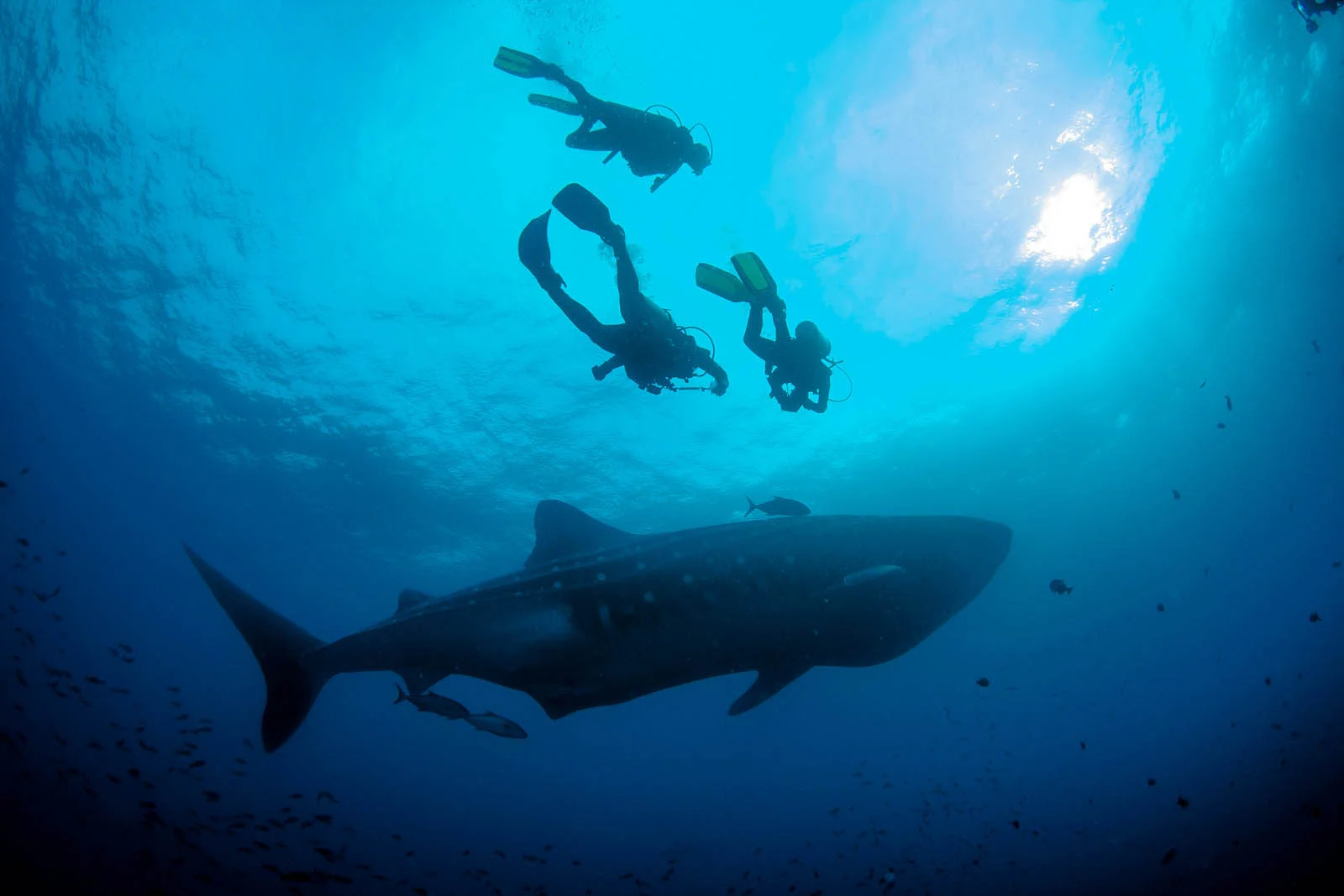
Galapagos Shark Safari: Dive into an Underwater Wonderland | Travel Blog
Table of content
Galapagos Sharks: An Enthralling Underwater Adventure
Unlocking the Secrets of Galapagos Sharks
Diving into the Realm of Galapagos Sharks
Snorkeling with Galapagos Sharks
Safety First: Diving with Galapagos Sharks
Galapagos Sharks: An Enthralling Underwater Adventure
Imagine yourself in the mesmerizing waters of the Galapagos Islands, where a hidden world of graceful, powerful creatures awaits your discovery. Dive deep into this aquatic wonderland, and you'll find yourself surrounded by one of the most diverse and remarkable shark populations on the planet. In this comprehensive guide, we'll navigate the thrilling realm of Galapagos sharks, from where to encounter them to their conservation status and more. So, let's plunge in!
Unlocking the Secrets of Galapagos Sharks
The Galapagos Islands are not just a haven for biodiversity on land; they also shelter an astonishing array of marine life, including 32 different shark species. Within the protective embrace of the Galapagos Marine Reserve, these enigmatic creatures find sanctuary and a wealth of nourishment.
The magic of the Galapagos lies in the convergence of nutrient-rich cold currents with warmer tropical waters. This dynamic mix creates a diverse marine habitat, spanning from tropical and temperate to cold waters, making it an ideal hub for various shark species. Some call these waters home year-round, while others are migratory, cruising through during optimal feeding times. As recently as 2012, a new species of catshark was uncovered in the Galapagos, signaling that these waters still guard many secrets beneath the surface.
Diving into the Realm of Galapagos Sharks
To immerse yourself in the world of Galapagos sharks and witness their diversity and abundance, a scuba diving adventure is highly recommended. It's your passport to get as close as possible to these captivating creatures and capture breathtaking underwater photos that will leave your friends in awe.
For an extraordinary experience, consider embarking on a specialist live-aboard dive yacht tour, such as the Aggressor III or Galapagos Sky. These cruises journey to the finest dive sites, particularly Darwin Island and Wolf Island, where you'll find the most significant shark biomass globally —an astonishing average of 17.5 shark tons per hectare! These well-equipped yachts come with experienced naturalist dive guides, ensuring you're in safe hands. While these cruises may not be the cheapest option, they are your best bet to encounter hammerheads and the magnificent whale sharks.
If you're seeking a more budget-friendly alternative, don't despair. Galapagos offers day tours that cater to divers, such as Gordon Rocks (Santa Cruz Island) and Kicker Rock (San Cristobal Island).
These sites provide opportunities to spot white and blacktip reef sharks and the iconic Galapagos Shark. Scalloped hammerheads occasionally grace these waters, adding to the excitement.
Snorkeling with Galapagos Sharks
Not a certified diver? No worries! You can still enjoy captivating encounters with Galapagos sharks through snorkeling. The archipelago's shallow coral-rich waters are favored by reef sharks, making them regular inhabitants of these areas. With a bit of luck, you might even spot a stray hammerhead in the crystal-clear waters. Snorkeling is a daily activity included in many Galapagos cruises and land tours. Some of the prime snorkeling sites to catch glimpses of these oceanic predators include Los Tuneles (Isabela island), Darwin Bay (Genovesa island), and North Seymour. Get ready to be entranced by these magnificent creatures.
Safety First: Diving with Galapagos Sharks
Safety is paramount, and Galapagos is known for being a safe destination for shark encounters. Records dating back to the mid-1800s show just eight shark-related incidents in the Galapagos Islands. Tourists have been involved in only three of these incidents, and there has never been a fatality resulting from a Galapagos shark attack.
Nonetheless, it's essential to exercise caution when sharing the waters with sharks. We recommend snorkeling or diving with an experienced naturalist guide who can discern shark behavior and ensure your safety. Remember to respect their space and maintain a safe distance.
If a shark shows curiosity, allow it to approach you rather than initiating contact.
In summary, the Galapagos Islands are a remarkably safe destination for shark enthusiasts.
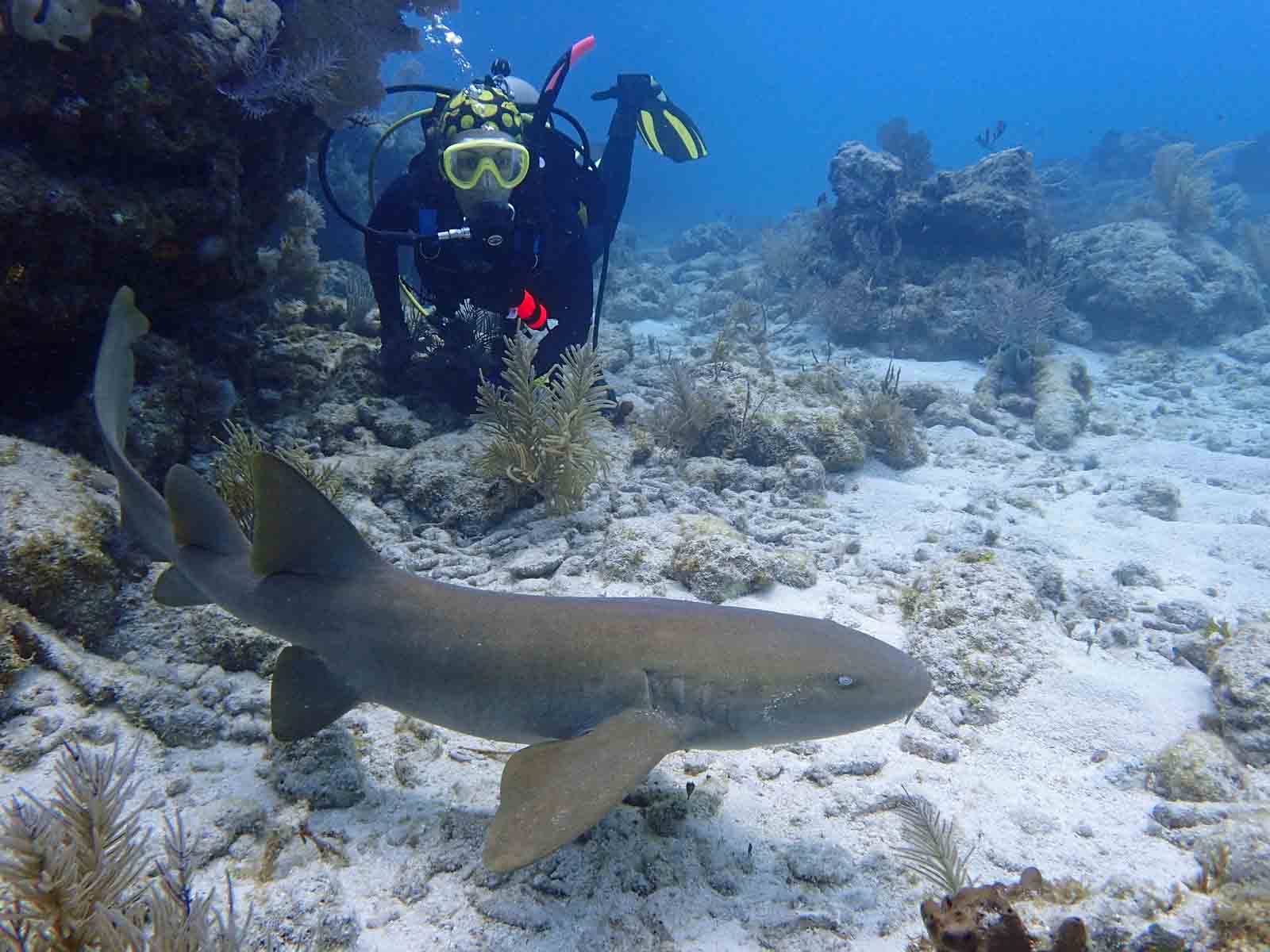
A Dive into the World of Galapagos Sharks
As we embark on this underwater adventure, let's explore the intriguing world of Galapagos sharks. While this list isn't exhaustive, it covers the most commonly encountered shark species in these waters.
Galapagos Hammerhead Shark
- Where to Find Them: Darwin & Wolf Islands, occasionally at day dive sites like Gordon Rocks or Kicker Rock.
- Best Time to Spot Them: Year-round, with peak sightings from December to April when waters are warmest.
Without a doubt, the scalloped hammerhead shark is a crown jewel of the Galapagos underwater world. It's the most commonly spotted species, with occasional glimpses of smooth and great hammerheads. These majestic creatures gather in schools of hundreds in the warm waters to the northwest of the archipelago, feasting on abundant schools of fish. Galapagos dive cruises offer the best chance for a thrilling sighting. Additionally, a vital hammerhead shark nursery site was recently discovered near Santa Cruz Island, providing a unique opportunity to witness baby hammerhead pups in their natural habitat.
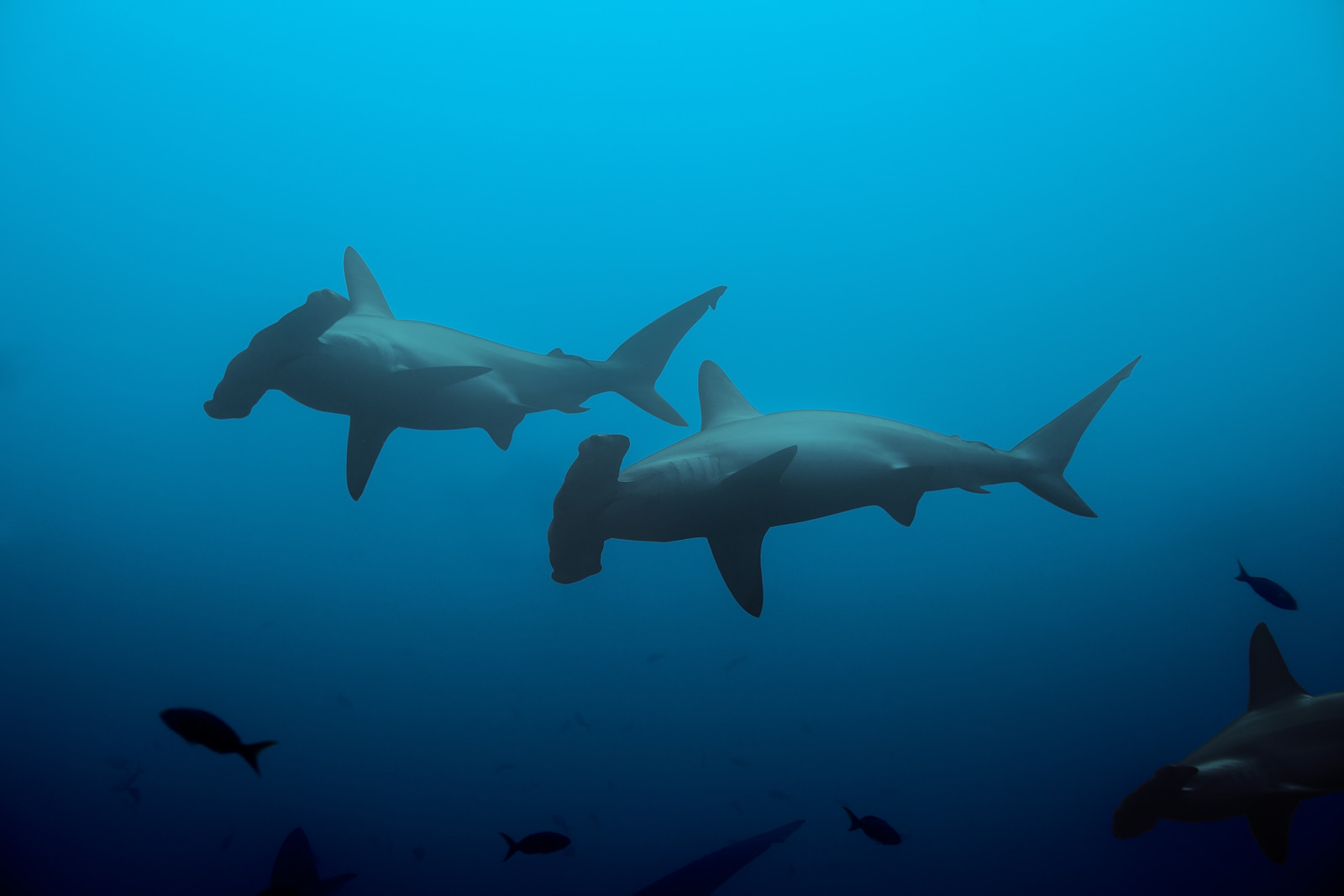
Whitetip Reef Shhark
- Where to Find Them: Across the archipelago, in shallow waters near coral reefs.
- Best Time to Spot Them: Active year-round.
The whitetip reef shark is the most common shark species in the Galapagos Islands.
Recognizable by the white tips on their first dorsal and upper caudal fins, these docile yet inquisitive sharks are often seen while snorkeling. Los Tintoreras on Isabela Island is an excellent spot for observing whitetips from land as they seek shelter in shady lava crevices during the day. At night, they transform into skilled hunters, preying on reef fish.
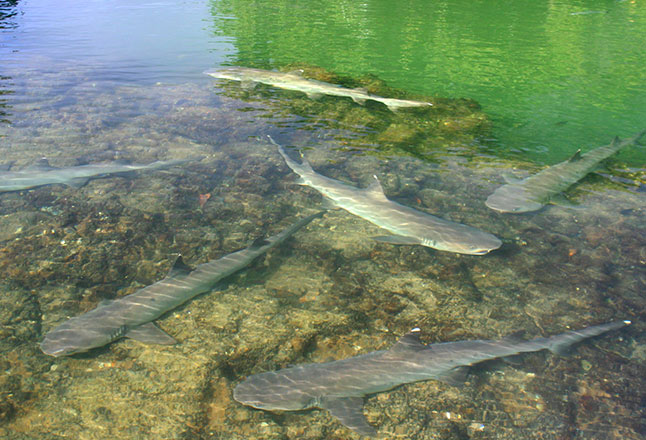
Galapagos Shark
- Where to Find Them: Darwin & Wolf Islands, and occasionally at day dive sites.
- Best Time to Spot Them: Year-round.
The Galapagos shark, one of the largest Requiem Shark species, can reach lengths of up to 3 meters as adults. Although they are found worldwide, the largest population thrives in the Galapagos Islands, where they were first identified in the 1950s. Galapagos sharks primarily hunt bottom-dwelling fish but have also been known to target fur seals, sea lions, and even marine iguanas on occasion. The best opportunities to encounter Galapagos sharks are on dive cruises to Darwin and Wolf islands, with occasional sightings near Santa Cruz, San Cristobal, or Isabela islands.
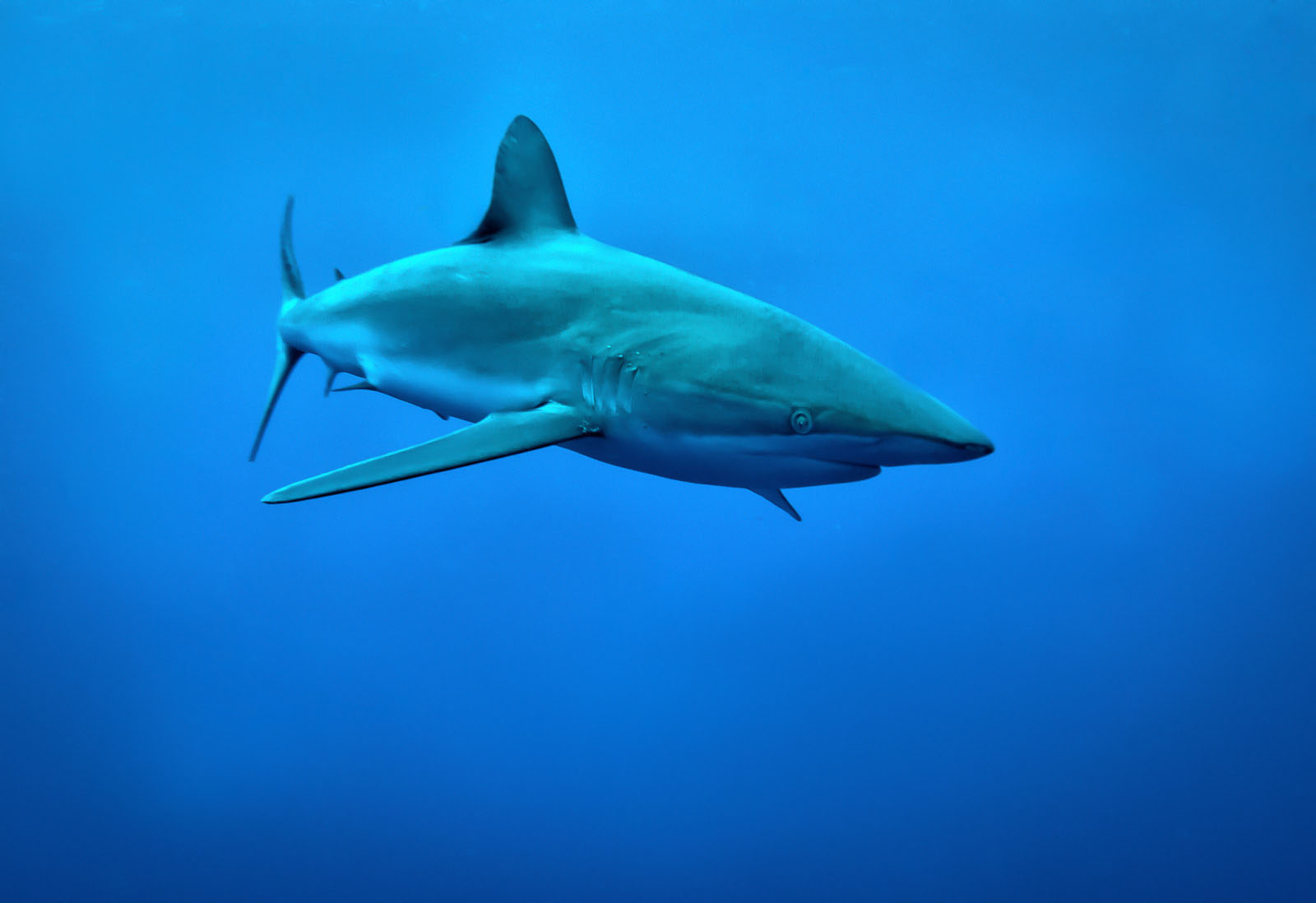
Whale Shark
- Where to Find Them: At Darwin & Wolf islands, especially in the seas around Darwin Arch.
- Best Time to Spot Them: The best time for whale shark sightings is from June to November.
The magnificent whale shark, the world's largest shark species, finds its prime diving grounds at the Galapagos Islands. To witness these gentle giants, you'll need to join a specialized scuba cruise to Darwin and Wolf islands, where massive adult females pass through during their migratory routes. Whale sharks are more common during the colder water months in the Galapagos when plankton, their primary food source, is abundant. Interestingly, over 90% of Galapagos whale sharks are pregnant females, a phenomenon yet to be fully understood. A significant project is underway to unravel more about their movements and behavior.
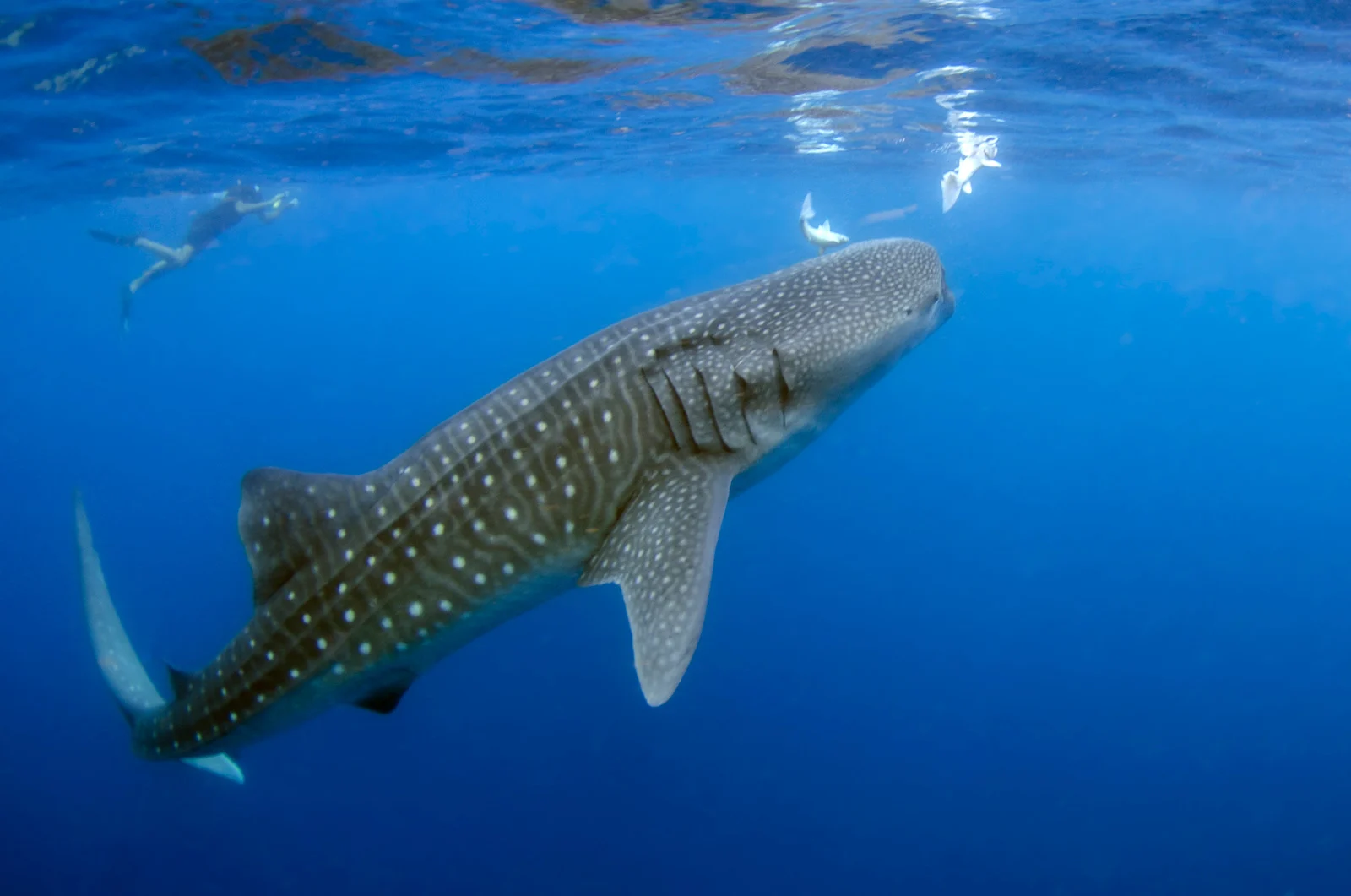
Blacktip Reef Shark
- Where to Find Them: Across the archipelago.
- Best Time to Spot Them: Active year-round.
The blacktip reef shark is another frequent sight in the Galapagos Marine Reserve, particularly in the warmer months from January to April. Recognizable by the black tips on all fins and their sleek, streamlined bodies, these sharks are often found near coral reefs or in open ocean waters. What sets them apart is their ability to breach, a stunning technique where they leap entirely out of the water.
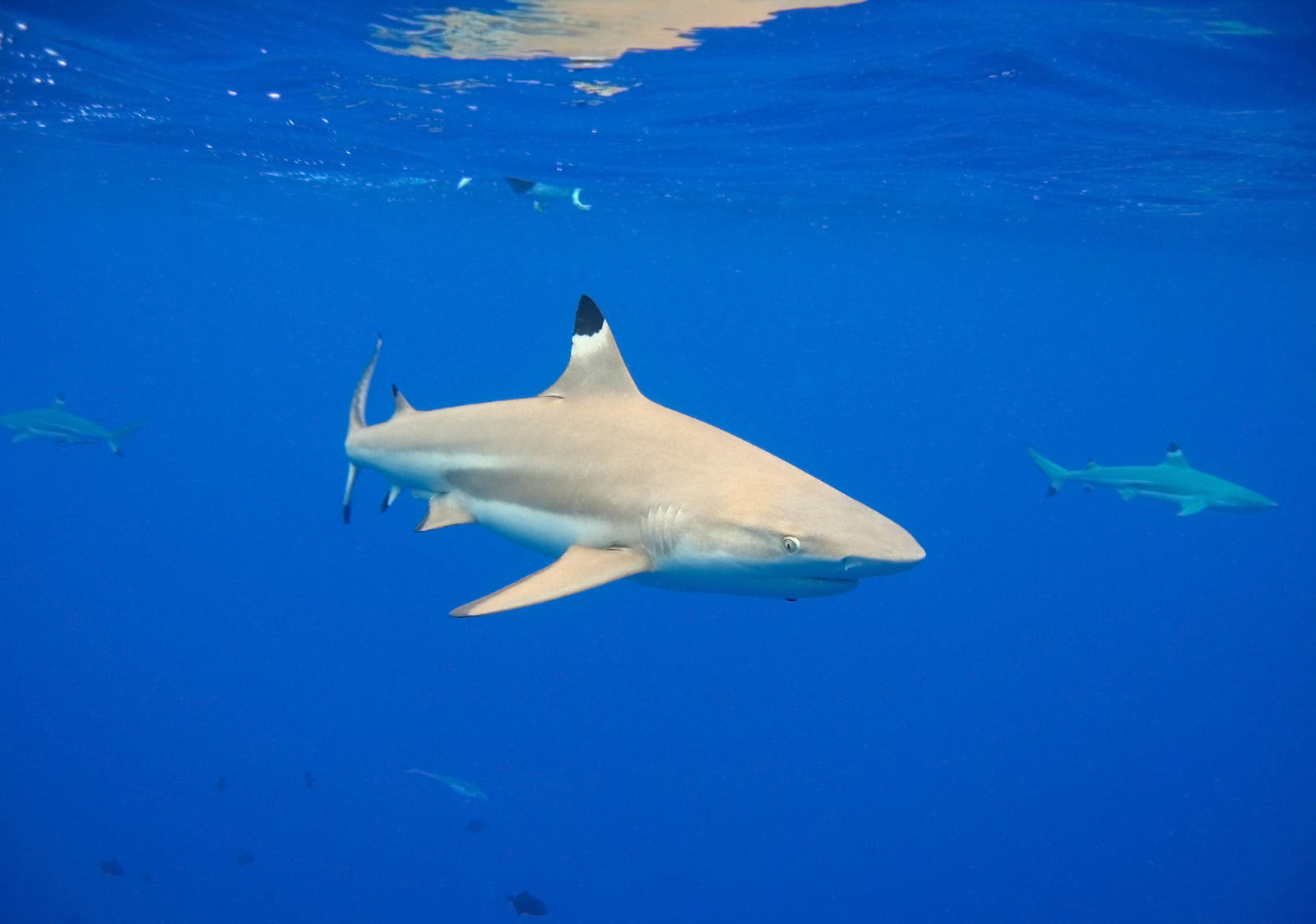
Galapagos Bullhead Shark
- Where to Find Them: Across the archipelago.
- Best Time to Spot Them: Active year-round.
The Galapagos bullhead shark remains shrouded in mystery. Very little is known about their habitat, behavior, or population size. What is clear is that these small-sized, bottomdwelling sharks boast a distinctive spotted body, dating back to the Jurassic Period.
Scientists are eager to uncover more about this enigmatic Galapagos shark species, and an active investigative project, supported by the Galapagos Conservation Trust, is underway.
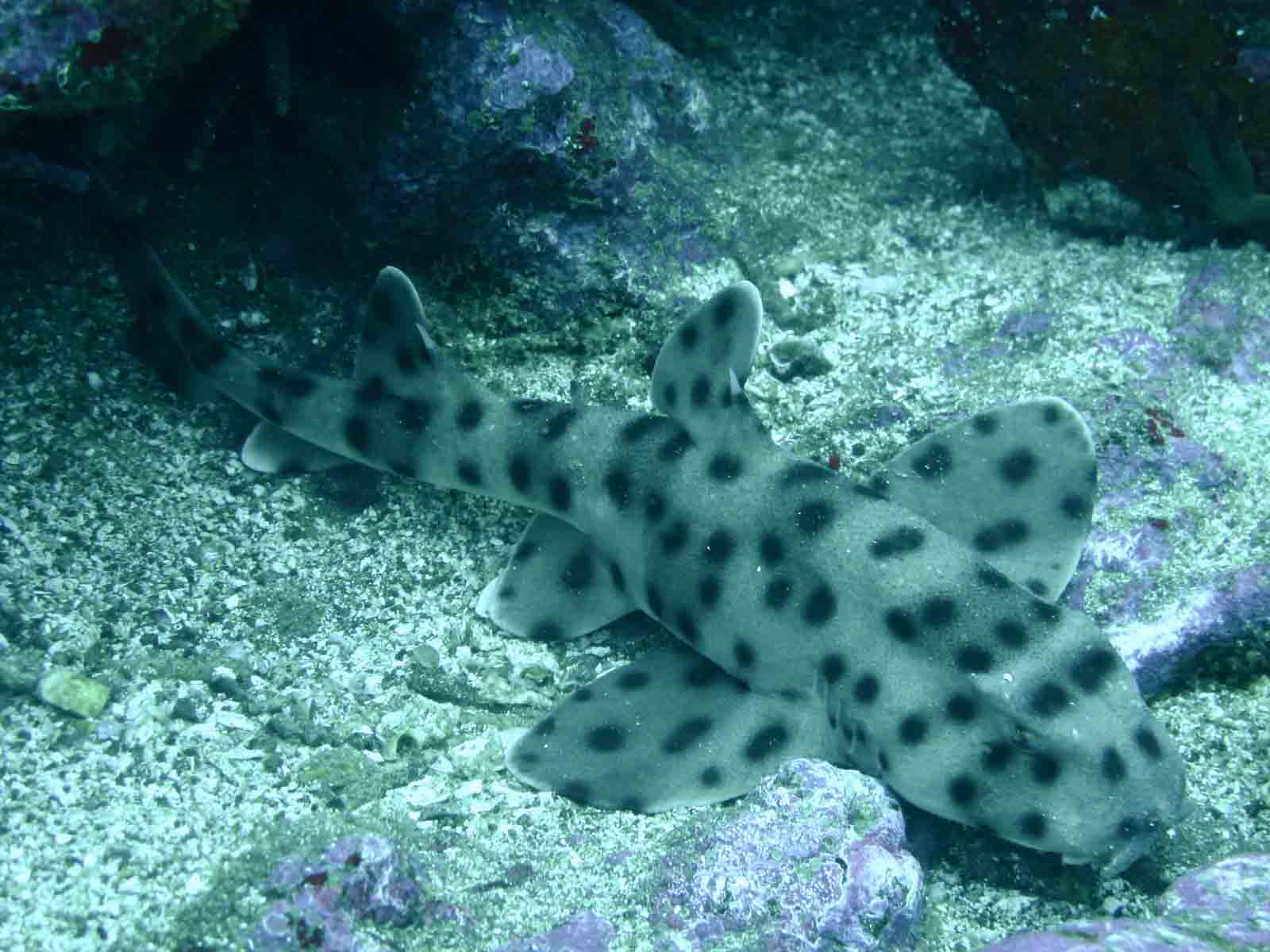
Tiger Shark
- Where to Find Them: At Darwin & Wolf Islands and sometimes in the Itabaca Channel between Baltra and Santa Cruz islands.
- Best Time to Spot Them: While tiger sharks may not be common in the Galapagos, they can be seen throughout the year, with the best sightings reported from February to June.
Tiger sharks need no introduction. As the fourth-largest shark species globally, they can reach an imposing length of 5.5 meters and are known for their predatory prowess. These migratory sharks occasionally pass through Galapagos waters and play a crucial role in maintaining a healthy ecosystem by controlling the populations of their prey, such as green turtles and sea lions.
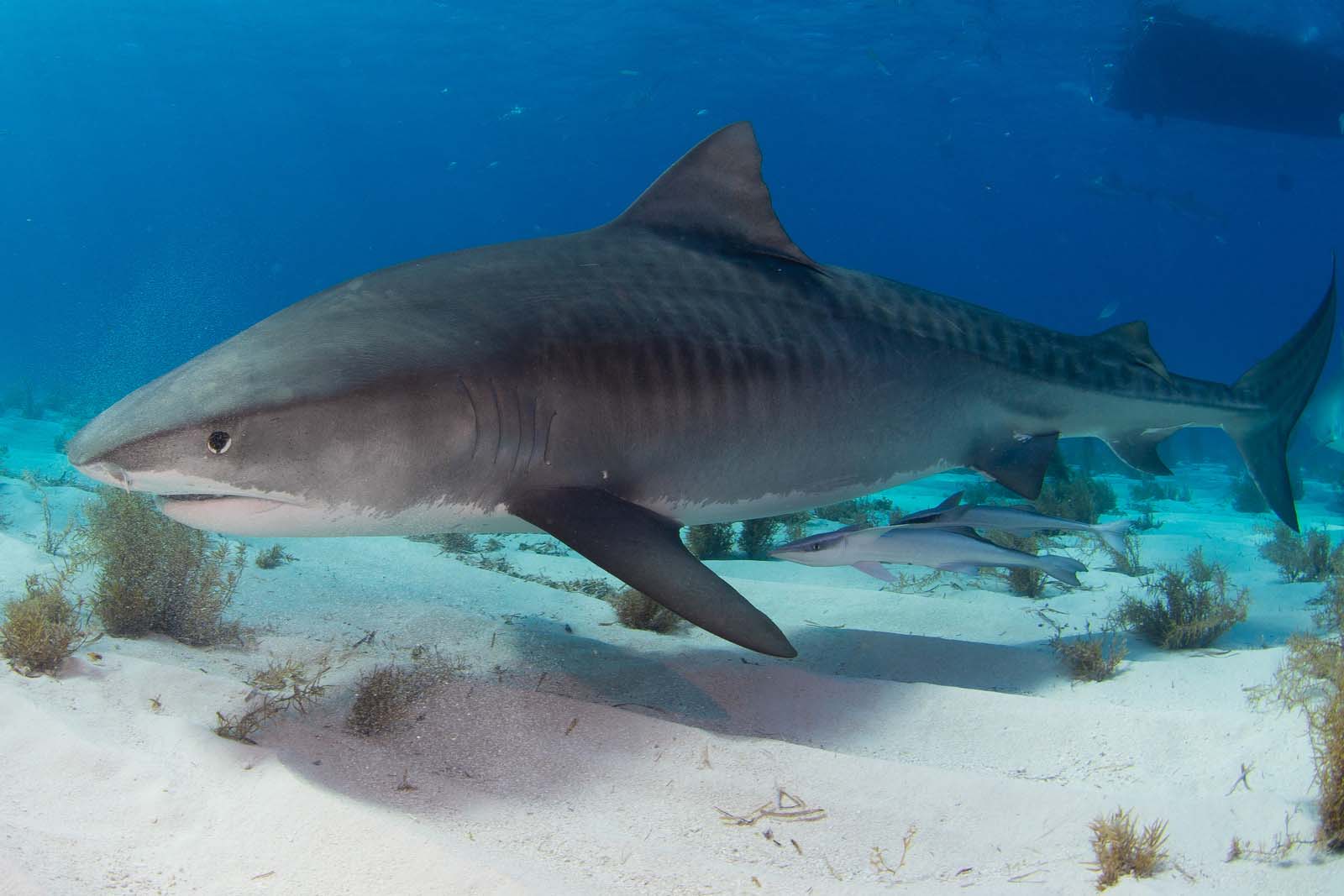
Dusky Shark
- Where to Find Them: Darwin & Wolf Islands.
- Best Time to Spot Them: Active year-round.
The dusky shark, another Requiem species, is often mistaken for the Galapagos shark due to its similar appearance. However, it is distinguished by a slightly larger dorsal fin. These sharks are widely distributed along coastlines with warm tropical waters. While they can be spotted year-round in the Galapagos, they are most frequently encountered from January to April when water temperatures are at their warmest.
Silky Shark
- Where to Find Them: Darwin & Wolf Islands.
- Best Time to Spot Them: Active year-round.
Silky sharks occasionally visit the Galapagos Marine Reserve, particularly during the warmer months from January to April. Recognizable by their smooth, silky skin and a long free tip on the second dorsal fin, these pelagic sharks are often found in deep waters near reefs or in the open ocean.
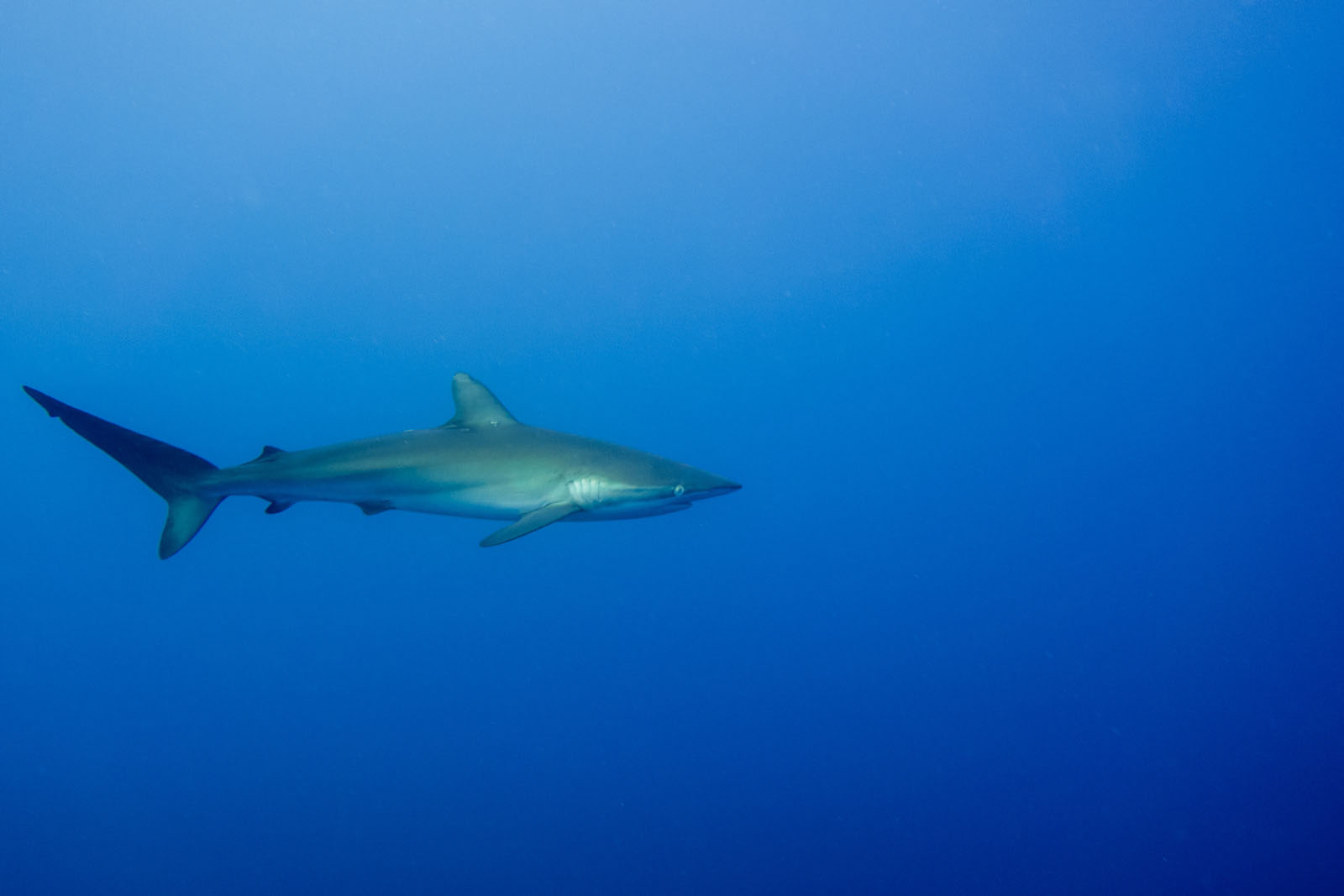
Challenges in Safeguarding Galapagos Sharks
Today, the Galapagos Islands remain one of the few places on Earth where shark populations thrive. This remarkable feat can be attributed to their protected status within the Galapagos Marine Reserve.
However, the conservation of Galapagos sharks is not without challenges. The whale shark, for instance, is an endangered species, while the scalloped hammerhead is critically endangered. The Galapagos bullhead shark remains a mysterious and under-researched species. The demand for illegal shark fins in the Chinese market poses a significant threat to many shark species. While these sharks are safeguarded within the marine reserve, most are migratory and susceptible to capture once they venture beyond protected waters.
Ecuadorian protective laws have played a pivotal role in addressing these concerns. In 1998, the Special Law for Galapagos established the 133,000 square kilometer Galapagos Marine Reserve (GMR) and banned commercial fishing activities, including shark finning and long-lining.
Furthermore, in 2004, Ecuador took a significant step by prohibiting the export of shark products, making it a global leader in shark conservation. However, some progress was eroded in 2007 when shark fins from incidental catches were allowed to be exported. Much work remains to be done to reinforce these protective measures.
Recent incidents underscore the ongoing threats from illegal fishing in the Galapagos Marine Reserve. In August 2017, a Chinese fishing vessel was apprehended within these waters, carrying thousands of captured sharks. While the crew faced legal consequences, the ecological damage was irreversible. In 2020, a massive Chinese fishing fleet remained near the Galapagos Marine Reserve's border for several weeks, raising ethical concerns despite legality. These actions cast shadows on the conservation efforts aimed at protecting Galapagos sharks.
In conclusion, the Galapagos Islands offer a treasure trove of intriguing shark species for you to explore. With the highest shark biomass on the planet, these waters are a safe haven for these magnificent creatures. Galapagos tours provide exceptional opportunities to get up close to these sharks and other marine species, ensuring unforgettable experiences for adventurers of all kinds. So, don your fins and snorkel gear, and let's dive into this remarkable world of Galapagos sharks!
Ready to Dive into the World of Galapagos Sharks?
Don't miss the chance to embark on your own Galapagos adventure and witness the awe-inspiring shark encounters in person. Book your Galapagos tour now and make unforgettable memories beneath the waves!
Check Our Galapagos Cruises:



